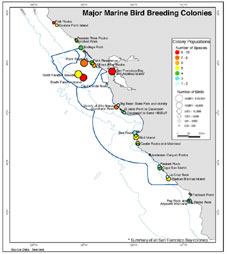|
by Walter Bonora
National Marine Sanctuaries
Seabirds. They are as much a symbol of the ocean as ships, sailors and sandy beaches, and are featured in countless photographs, paintings, films, books and even songs about the sea. But along California’s central coast, their numbers have been nothing to sing about.
Over the past century, seabird populations in the region have been on a downward slide, and humans have been a big part of the problem. By the late 1980s, tens of thousands of birds had been killed by gill nets, spill incidents and other human activities, leaving once thriving nesting grounds virtually barren. In 1986, more than 6,000 murres were killed by a single tanker spill off San Francisco.
One of the most significant threats that humans pose to seabirds, say scientists, comes from disturbing the birds where they nest and breed.
 |
| Click here for a larger version of the breeding map. |
|
|
“Too often, when people get too close to the bird colonies, whether by aircraft or by boat, the birds scatter en masse,” says Jennifer Boyce, a restoration ecologist with NOAA’s Restoration Center. “When this happens, nests, eggs and chicks are abandoned, leaving them vulnerable to the elements and exposed to predators like gulls and ravens. Repeated disturbances can result in birds abandoning their colonies forever.”
But help is on the way. To put seabird colonies on California’s central coast back on the road to health, NOAA, the U.S. Fish and Wildlife Service, and several California state and non-governmental agencies have created the Seabird Colony Protection Program, an innovative outreach and monitoring effort that enlists the help of those who use and enjoy the sea, shore and sky to minimize their impact on seabird nesting and breeding grounds.
“We are excited about developing this program,” says Karen Reyna, a resource protection specialist with Gulf of Farallones National Marine Sanctuary. Reyna coordinates the effort for the NOAA National Marine Sanctuary Program. “It is a chance to address human disturbances through an organized, monitoring and management system, and restore once thriving seabird populations.”
Nesting seabird populations are significant living resources of Gulf of the Farallones sanctuary and its surrounding waters, with the Farallon Islands supporting one of the largest concentrations of breeding seabirds in the contiguous United States. To get the bird numbers healthy again, the seabird program team will apply creative outreach efforts and rely on proven monitoring methods.
To reach out to ocean users like kayakers, boaters and fishermen, the team will place buoys in sensitive areas, reminding people to keep a safe distance. The team will also send special maps to airports to make pilots aware of flying restrictions near bird breeding grounds. Then colonies will be monitored to see how many planes scatter birds and disturb their nests. If disturbances don’t decrease, then additional pilot outreach materials will be developed.
Boyce has high hopes for the project, and sees it as an excellent tool in the ongoing seabird protection efforts throughout California. “What we hope to see from this project is a reduction in human disturbance to the colonies,” she says. “To do that, we want to educate the public in how to safely view wildlife.”
Efforts like the Seabird Colony Protection Program are another example of how the NOAA National Marine Sanctuary Program, working with numerous partners, uses science and education to managing living resources.
Top Photo: The NOAA National Marine Sanctuary Program and other federal agencies aim to protect and rebuild populations of seabirds along the Central California coast, like these common
murres, whose numbers dwindled dramatically in the 1980s. (Photo: NOAA)
|





